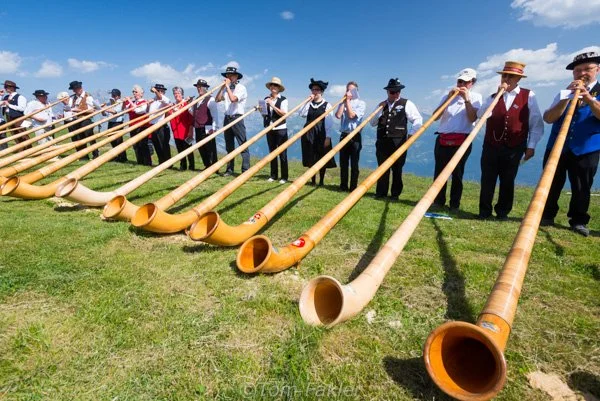Traditionally a herdsman’s mountain call instrument, but also surprisingly beautiful and with full range, this distinctive long wooden, often curved trumpet is most common in Switzerland, across the European Alps, Scandinavia, Russia, Hungary and Romania. It is without valves or holes and notes are played by changing the airflow and lip tension. Accomplished players often command a range of nearly three octaves, consisting of the 2nd through the 16th notes of the harmonic series, Lower notes are very powerful, but limitations of higher tones is due in part to the relatively small diameter of the bore of the mouthpiece and tubing in relation to the overall length of the horn.
Alphorns, with a known history going back to at least the 15th century, are often around 2 metres in length, but can be longer often 3.5 metres, since 15th century, and in Slovakia some have been known to be 5 metres.
There are unconfirmed origins in Roman culture, with mentions in 1st-century writings by Tacitus of ‘cornu alpinus’, with the earliest specimen from the 9th-century Oseberg ship in Olso, suggesting they may have been used as summoning or military instruments, but it became a more common sound and sight in early medieval northern Europe and certainly more established by the 15th century.
Alphorns are made from mountain softwood, particularly pine, hollowed out. Traditionally craftsmen would have used a tree with a curved trunk, but modern models are made in sections.
With it’s mountain herding origins, perhaps the best known traditional melody is the Kühreihen or Ranz de Vaches (calling of the cows):
This melody is also used in the 3rd movement of Rossini’s William Tell Overture:
But the instrument has also been extensively by classical composers integrating folk and other traditions into a more formal setting, sometimes highlighting the instrument at the centre of a piece. Examples include the Concerto Grosso No. 1 (2013) for four alphorns and orchestra by Georg Friedrich Haas, Sinfonia pastorale for corno pastoriccio in G (alphorn) and string orchestra (1755) by Leopold Mozart, father of the famous Wolfgang Amadeus Mozart. Other examples include Concerto for alphorn and orchestra (1970) by Jean Daetwyler, who also wrote the 1983 Concerto No. 2 for alphorn (with flute, string orchestra and percussion) (1983) and Dialogue with Nature for alphorn, flute, and orchestra. Others include Super Alpen King for three alphorns and orchestra by Ghislain Muller (2001), and Concertino Rustico (1977) by Ferenc Farkas.
Here’s Jean Daetwyler’s (1907-1994) Dialogue with Nature for alphorn, flute, and orchestra, rather beautifully bringing together one of the largest instruments with one of the smallest:
And here is the very skilled duo, Rauschhorn, featuring Christoph Im Obersteg & Thomas M Rüst, playing the Choral für Luzern by Anton Wycki:
Lisa Stoll, as Swiss alphorn soloist from Wilchingen, is another established player, here with the Alphorn Fantasy, joined by the Philharmonic Wind Orchestra, conducted by Marc Reift.
And finally, in the dramatically beautiful sound and setting of Zermatt in Switzerland, 508 players break the world record for biggest ensemble of alphorn players.
So then, any more alphorn music or cultural references come to mind? Feel free to share any further ones from songs, or even film, art or other contexts in comments below.
You can also get in touch the contact page, and also visit us on social media: Song Bar Twitter, Song Bar Facebook. Song Bar YouTube. and Song Bar Instagram. Please subscribe, follow and share. New to comment? It is quick and easy. You just need to login to Disqus once. All is explained in About/FAQs ...
Song Bar is non-profit and is simply about sharing great music. We don’t do clickbait or advertisements. Please make any donation to help keep the Bar running:

